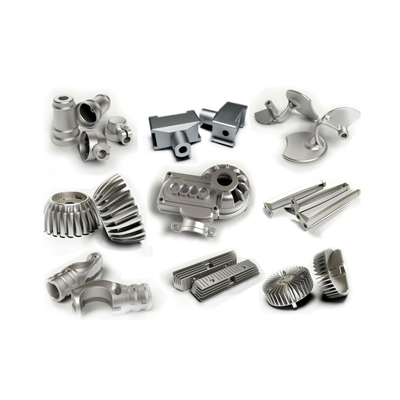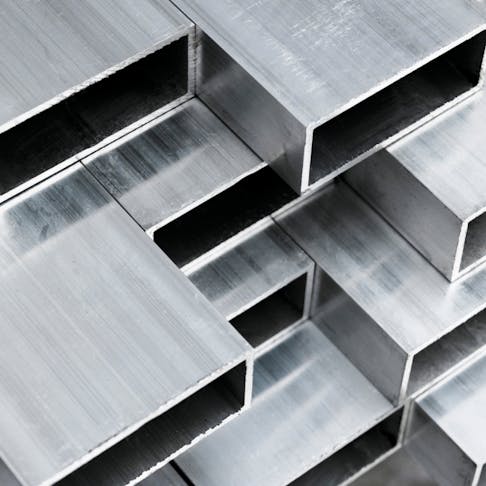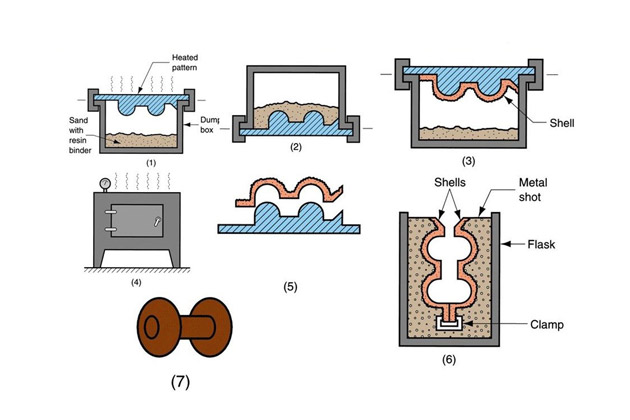Whatever You Required to Understand About the Uses and Benefits of Aluminum Castings
Aluminum castings play a necessary function throughout different sectors, supplying unique properties that boost item efficiency. Their lightweight nature and stamina make them perfect for applications in automobile and aerospace sectors. In addition, the adaptability of casting techniques enables detailed designs and tight resistances. As the need for sustainable services climbs, recognizing the advantages and applications of aluminum castings ends up being significantly crucial. What certain benefits do they supply over other products?
Overview of Aluminum Casting Processes
Aluminum casting procedures include a range of techniques utilized to form liquified aluminum into preferred kinds. These methods consist of sand spreading, die spreading, and financial investment spreading, each offering unique benefits depending upon the application (Aluminum Casting). Sand spreading includes creating a mold and mildew from sand, allowing for detailed styles and huge elements, while die spreading uses high pressure to inject liquified aluminum into metal molds, making sure precision and smooth surfaces. Financial investment casting, additionally known as lost-wax spreading, generates complex forms with outstanding dimensional precision, making it suitable for comprehensive parts
These processes are defined by their capacity to produce lightweight, long lasting components that exhibit superb corrosion resistance. The versatility of aluminum permits personalization in numerous industries, from automobile to aerospace. In addition, the ability to recycle aluminum improves the sustainability of these casting processes, reducing environmental effect while keeping product integrity. Understanding these strategies is vital for maximizing manufacturing effectiveness and achieving high-quality aluminum castings.
Key Applications of Aluminum Castings
Aluminum castings play an essential function across different markets, especially in auto, aerospace, and customer electronic devices. In the auto field, they add to light-weight frameworks that boost fuel performance. In a similar way, aerospace parts profit from aluminum's strength-to-weight proportion, while customer electronics utilize its versatility for efficient manufacturing.
Automotive Market Applications
As the automobile market remains to progress, makers increasingly depend on aluminum castings for their lightweight yet sturdy buildings. These castings play an essential function in improving vehicle performance, fuel performance, and general safety. Trick applications consist of engine blocks, transmission real estates, and architectural elements, which profit from aluminum's superb strength-to-weight proportion. In addition, aluminum castings help with complex geometries, permitting for ingenious designs that boost aerodynamics and decrease drag. The deterioration resistance of aluminum likewise adds to long life, reducing maintenance prices for both makers and consumers. As electrical lorries gain appeal, aluminum castings are necessary for battery enclosures and various other parts, further strengthening their significance in the future of auto production.
Aerospace Element Production
In the aerospace market, aluminum castings are important to the manufacturing of light-weight, high-performance components. These castings are crucial for producing components such as engine real estates, structural structures, and landing gear components, where weight decrease is important for fuel effectiveness and total performance. The superb strength-to-weight proportion of aluminum permits the development of complicated geometries that boost aerodynamics. In addition, aluminum's resistance to corrosion contributes to the long life and dependability of aerospace parts, making certain safety in flight operations. The spreading process also enables accurate resistances, which is essential in conference stringent aerospace industry requirements. In general, aluminum castings play a critical function beforehand aerospace modern technology while supporting the sector's push for sustainable practices.
Consumer Electronics Production
The usage of aluminum castings in consumer electronics production has actually come to be increasingly significant due to their light-weight and durable properties. Producers leverage these castings to create parts for numerous tools, consisting of mobile phones, laptop computers, and gaming consoles. Aluminum's excellent thermal conductivity likewise helps in warm dissipation, enhancing tool performance and durability. Moreover, the convenience of aluminum permits for complex styles and intricate geometries, allowing smooth and modern aesthetic appeals that attract consumers. Furthermore, aluminum castings can be quickly reused, lining up with the expanding need for sustainable production techniques. As innovation advancements, the function of aluminum castings in establishing cutting-edge and efficient consumer electronic devices is expected to increase, making them a staple in the market.

Benefits of Utilizing Aluminum Castings
While numerous materials are offered for casting, aluminum attracts attention because of its special combination of light-weight residential properties, toughness, and corrosion resistance. The reduced density of aluminum makes it an optimal option for applications where weight decrease is critical, such as in the automotive and aerospace industries. Its exceptional strength-to-weight ratio enables suppliers to create resilient components without including excessive weight.
Furthermore, aluminum castings can be produced with intricate styles and tight resistances, allowing intricate geometries that are hard to achieve with various other materials. The convenience of aluminum enables various casting approaches, including sand, die, and investment spreading, accommodating varied manufacturing demands. Aluminum's convenience of machining and ending up boosts its appeal, helping with the development of top notch surface area coatings. On the whole, the benefits of making use of aluminum castings contribute to enhanced performance and effectiveness in various applications across different industries.
Rust Resistance in Aluminum Castings

All-natural Oxide Layer
An all-natural oxide layer types on the surface of aluminum castings, supplying a vital obstacle versus environmental variables that can cause degeneration. This thin, safety movie is a result of the aluminum's reaction with oxygen airborne, efficiently securing the underlying steel useful link from dampness, chemicals, and pollutants. Consequently, aluminum castings display impressive deterioration resistance, which boosts their longevity and durability in different applications. The oxide layer is not only valuable for security but likewise contributes to aesthetic top qualities, as it can create a matte coating that numerous sectors find appealing. In addition, this natural process decreases the need for additional coverings, making aluminum castings an affordable selection for makers seeking reliable, resilient products.
Alloy Variations Impact
The make-up of aluminum alloys substantially influences their corrosion resistance residential or commercial properties in castings. Various alloy variants, such as 1xxx, 2xxx, and 6xxx series, display unique degrees of susceptibility to rust. For example, 1xxx alloys, largely composed of pure aluminum, offer exceptional deterioration resistance due to their high pureness. On the other hand, 2xxx alloys, which include copper, may experience substantial corrosion when exposed to severe atmospheres. On the other hand, 6xxx alloys, including magnesium and silicon, strike a balance between toughness and resistance. The presence of alloying components can enhance or diminish protective read more oxide layers, ultimately impacting long life and efficiency. Recognizing these variants is essential for selecting the ideal alloy for details applications where deterioration resistance is essential.
Layout Versatility and Customization
Different materials exist for casting applications, aluminum stands out due to its remarkable design adaptability and possibility for personalization. This flexibility allows designers and designers to produce intricate forms and types that satisfy particular functional needs. Aluminum Casting. The low density of aluminum allows lightweight layouts, which is especially advantageous in industries such as auto and aerospace, where weight decrease is vital
Aluminum castings can be check my site tailored to numerous specs, including wall density, surface area coating, and dimensional tolerances. This adaptability not just enhances the visual appeal however also boosts the performance of the end product. Additionally, advanced strategies such as 3D printing and computer-aided layout (CAD) additional facilitate the customization procedure, making it possible for rapid prototyping and reducing preparations. As a result, aluminum castings can properly fulfill the varied demands of different markets while offering makers the ability to introduce and respond promptly to market demands.
Comparison With Other Casting Products
While different casting products each have their special benefits, aluminum regularly demonstrates premium properties that make it a preferred option in several applications. Contrasted to iron and steel, aluminum is significantly lighter, which reduces the overall weight of completed products, improving gas efficiency in vehicle and aerospace markets. Aluminum offers excellent corrosion resistance, calling for much less upkeep over time contrasted to products like iron, which can rust.
When compared with plastics, aluminum's toughness and durability surpass many synthetic alternatives, making it appropriate for demanding atmospheres. On top of that, aluminum's thermal and electrical conductivity is incredibly greater than a lot of various other metals, making it optimal for applications needing effective warm dissipation or electrical components.

Future Patterns in Aluminum Casting Innovation
Improvements in aluminum spreading innovation are set to redefine its applications throughout numerous markets. Advancements in automation and robotics are improving production procedures, improving efficiency and accuracy. The combination of synthetic intelligence and artificial intelligence allows real-time tracking and anticipating maintenance, reducing downtime and boosting quality assurance.
The development of innovative alloys is increasing the efficiency abilities of aluminum castings, making them suitable for even more demanding applications, especially in automotive and aerospace fields. Sustainable techniques are likewise acquiring grip, with boosted focus on recycling aluminum and reducing carbon impacts throughout production.
Additive production strategies, such as 3D printing, are being discovered to create complicated geometries that typical techniques can not attain, permitting greater layout flexibility. These patterns show a future where aluminum spreading will not just satisfy yet go beyond industry expectations, driving innovation and sustainability in production.
Often Asked Concerns
How Are Aluminum Castings Recycled After Use?
Aluminum castings are usually collected, cleansed, and refined in reusing facilities. The product is thawed down, fine-tuned, and then changed into brand-new products, thus preserving resources and minimizing environmental effect while maintaining aluminum's preferable homes.
What Are the Common Costs Connected With Aluminum Castings?
The typical costs related to aluminum castings differ based upon variables such as intricacy, quantity, and product requirements. Usually, prices range from a couple of dollars per extra pound to considerably greater amounts for intricate styles and large quantities.
How Do Aluminum Castings Compare in Weight to Steel Castings?
Aluminum castings weigh substantially less than steel castings, generally around one-third the weight (Aluminum Casting). This reduced mass enables less complicated handling, transportation, and application in various markets, adding to enhanced efficiency in style and manufacturing procedures
What Industries Largely Depend On Aluminum Castings?
Different markets substantially count on aluminum castings, consisting of auto, aerospace, electronic devices, and consumer items. Their lightweight nature, rust resistance, and convenience make them essential for producing parts in these industries, boosting performance and efficiency.
Are There Any Wellness Dangers Related To Aluminum Casting Processes?
Health and wellness threats associated with aluminum spreading procedures include exposure to fumes, dirt, and chemicals, which can lead to breathing concerns and skin irritation. Appropriate precaution and equipment are necessary to reduce these prospective dangers in the workplace.